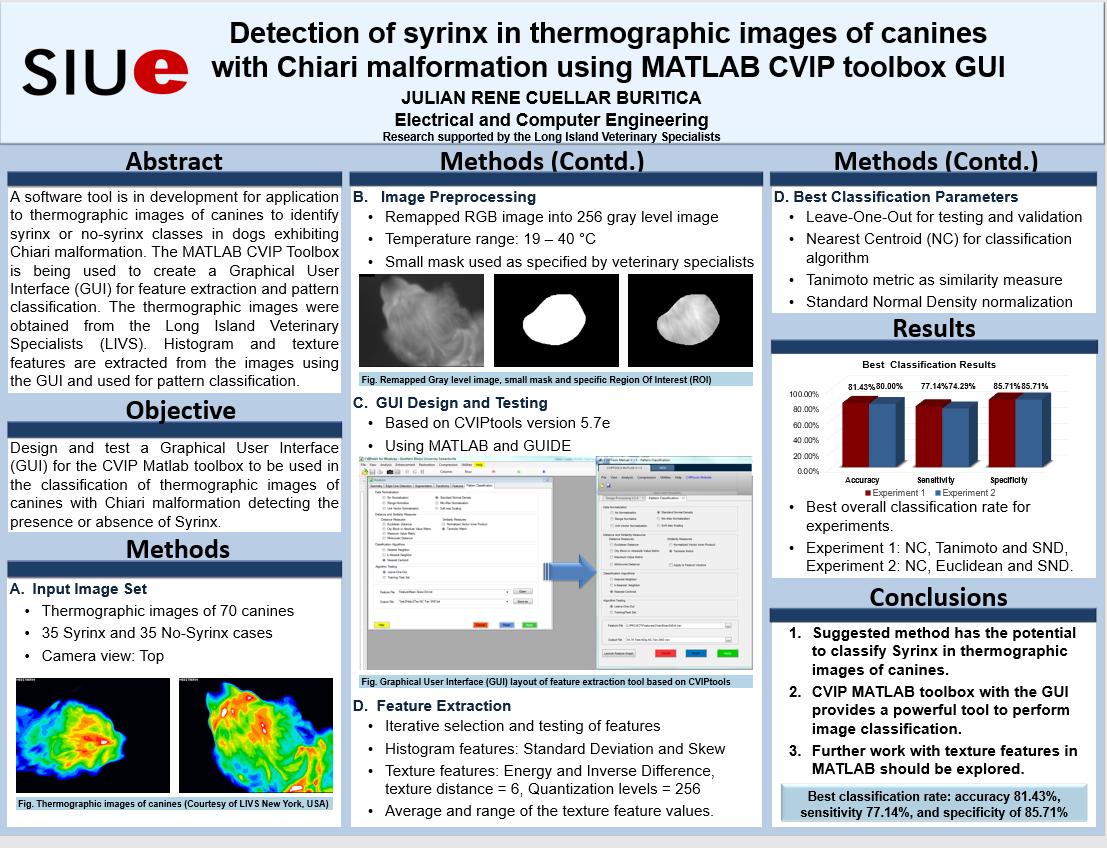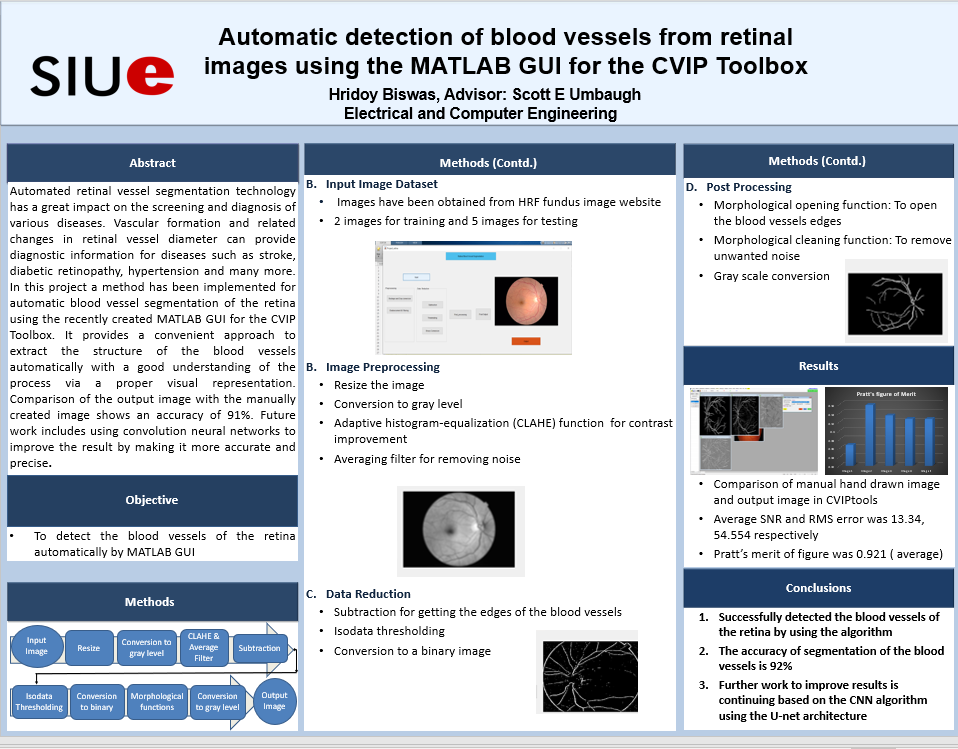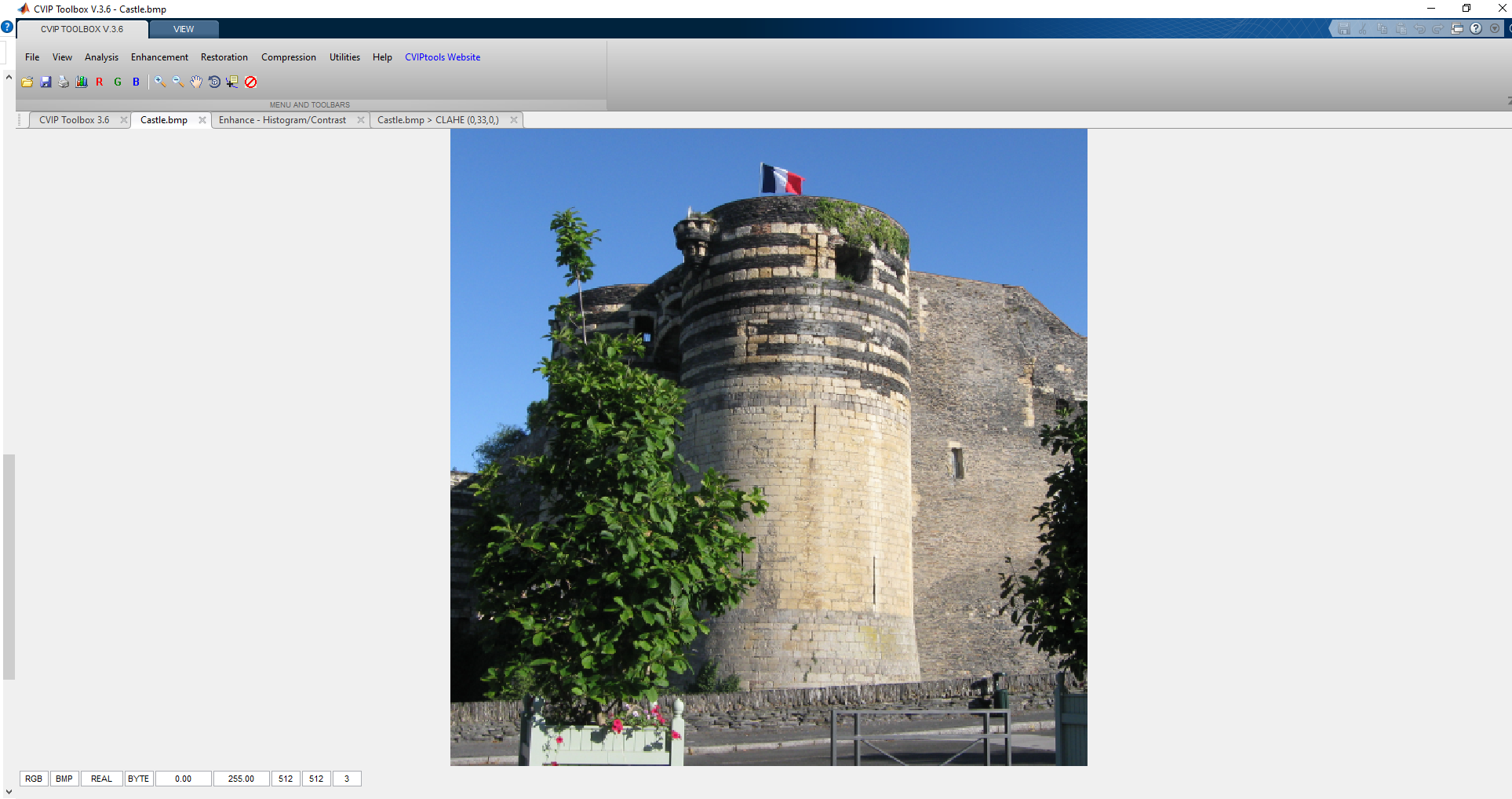Current Research and Development Projects
Veterinary Thermographic Image Analysis
The veterinary thermographic image analysis projects have been funded since 2006 by the Long Island Veterinary Specialists (LIVS) and the New York Veterinary Foundation since 2017. Thermographic imaging is much easier, faster and less expensive than standard medical imaging methods such as MRI and CT scans. These projects include research and development using thermographic images to aid in screening and pathology identification for bone cancer, ruptured anterior cruciate ligament (ACL), feline hyperthyroidism, Chiari malformation, inter-vertebral disc disease, and gait analysis. The results of this research have been used to develop a clinical application software that is currently being tested in the labs at LIVS.
Publications
•“Automatic mask creation of thermographic gait images using CVIPtools ATAT”, CB Stacey, SE Umbaugh, DJ Marino, J Sackman, Proceedings of SPIE, Vol. , Thermosense: Thermal Infrared Applications XLII, April 11-15, 2021
•“Comparison of K-means and K-means++ for image compression with thermographic images”, H Biswas, SE Umbaugh, DJ Marino, J Sackman, Proceedings of SPIE, Vol. , Thermosense: Thermal Infrared Applications XLII, April 11-15, 2021
•“Identification of bone cancer in canine thermograms”, N Gorre, SE Umbaugh, DJ Marino, J Sackman, SPIE Defense + Commercial Sensing 2020, Proceedings of SPIE, Vol. 11409, Thermosense: Thermal Infrared Applications XLII, April 28-30 2020
• “Medical infrared thermal imaging of syringomyelia in the Cavalier King Charles Spaniel”, M Larkin, C Loughin, D Marino, C Dewey, S Umbaugh, J Sackman, BMC Veterinary Research, (2020) 16:137, Link
• “Detection of syrinx in thermographic images of canines with Chiari malformation using MATLAB CVIP toolbox GUI”, JC Buritica, A Karlapalem, SE Umbaugh, DJ Marino, and J Sackman, SPIE Commercial + Scientific Sensing and Imaging, 2019, Baltimore Convention Center, April 14-18, 2019, Proceedings of SPIE, Vol. 11004, Thermosense: Thermal Infrared Applications XLI, 1100405 (2 May 2019), DOI: 10.1117/12.2519112;Link
•"Image processing and pattern recognition with CVIPtools MATLAB toolbox: automatic creation of masks for veterinary thermographic images", D Mishra, SE Umbaugh, N Lama, R Dahal, D Marino, J Sackman, SPIE Optical Engineering + Applications Conference: Applications of Digital Image Processing XXXIX, August, 2016, Proceedings of SPIE Vol. 9971

Retinal Blood Vessels in Fundus Images
Research for the development of new methods, and improvement to existing methods, to automatically segment the blood vessels and blood vessel patterns in fundus (eye) images are being explored. This research is being applied for diagnostic purposes, in particular to the early identification of diabetic retinopathy. Diagnosis of eye disease in the early stages increases the ability for successful treatment and can often lead to saving the patient’s eyesight.
Publications
•“Machine learning with a convolutional neural network for segmentation of ophthalmological images”, H Biswas, SE Umbaugh, Proceedings of SPIE, Vol. , Thermosense: Thermal Infrared Applications XLII, April 11-15, 2021
• "A new algorithm for detecting smaller retinal blood vessels in fundus images." RW LeAnder, PI Bidari, TA Mohammad, M Das, SE Umbaugh, Proceedings of the SPIE Medical Imaging 2010 Conference, Vol. 7624, 7624-3B, pp. 1-7, February 13-18, 2010, San Diego, CA.
•“Comparison of two algorithms in the automatic segmentation of blood vessels in fundus images”, Proceedings of the SPIE Medical Imaging 2008 Conference, Vol. 6915, 69153H (2008); Feb 16-21, 2008, San Diego, CA, RW LeAnder, S Myneni, S Mokkapati, SE Umbaugh.

GUI Development for the CVIP Toolbox for Matlab.
A graphical user interface (GUI) is under development for the CVIP Matlab Toolbox. It is modelled from the standard Windows GUI for CVIPtools, with the intent of allowing Matlab users to explore computer vision and image processing from a GUI while also having a development program, CVIPlab, to access all the CVIP Matlab Toolbox functions. This will allow the user to test various imaging functions and develop algorithms while easily exploring the various parameters associated with each function.
Publications
• “Detection of syrinx in thermographic images of canines with Chiari malformation using MATLAB CVIP toolbox GUI”, JC Buritica, A Karlapalem, SE Umbaugh, DJ Marino, and J Sackman, SPIE Commercial + Scientific Sensing and Imaging, 2019, Baltimore Convention Center, April 14-18, 2019, Proceedings of SPIE, Vol. 11004, Thermosense: Thermal Infrared Applications XLI, 1100405 (2 May 2019), DOI: 10.1117/12.2519112;Link
•"Image processing and pattern recognition with CVIPtools MATLAB toolbox: automatic creation of masks for veterinary thermographic images", D Mishra, SE Umbaugh, N Lama, R Dahal, D Marino, J Sackman, SPIE Optical Engineering + Applications Conference: Applications of Digital Image Processing XXXIX, August, 2016, Proceedings of SPIE Vol. 9971

CVIP-ATAT Development.
The Computer Vision and Image Processing Algorithm Test and Analysis Tool, CVIP-ATAT, was created to facilitate the development of both human and computer vision applications. The primary function of this tool is to allow the user to explore many more algorithmic possibilities than can be considered by processing one image at a time with CVIPtools. It allows for the automatic processing of large image sets with many different algorithmic and parameter variations. We call this the “front-end” tool because its primary purpose is to find the best algorithm to preprocess, segment and post-process a set of images for a particular application in order to best separate the most important regions of interest within the image. It has a GUI which allows the user to enter multi-stage algorithms for testing and analysis. At each stage the user can specify a number of different processes to test and a range for the processes’ parameters. The user also specifies a set of images to process and a set of “ideal” output images which will be used to determine the success for each algorithm. CVIPtools web pages: CVIPtools .CVIPtools
Publications
• “Automatic mask creation of thermographic gait images using CVIPtools ATAT”, CB Stacey, SE Umbaugh, DJ Marino, J Sackman, Proceedings of SPIE, Vol. , Thermosense: Thermal Infrared Applications XLII, April 11-15, 2021
Segmentation of Liver Tissue Samples for Necrotic Region Detection.
The purpose of this project is to develop an improved algorithm that can automatically segment out the necrotic regions of a liver sample image. Each image to be segmented has had a hematoxylin and eosin (H&E) stain applied to it. By using the contrast provided by that stain, we can develop an algorithm to perform the segmentation. As there are many combinations, transforms and filters that can be performed to develop the algorithm, and due to the dataset being too large to test fully manually, we used the ATAT program within CVIPtools to test many combinations to determine an optimal algorithm.

CVIP-FEPC Development.
The Computer Vision and Image Processing Feature Extraction and Pattern Classification Tool, CVIP-FEPC, was created to facilitate the development of both human and computer vision applications. The primary function of this tool is to explore feature extraction and pattern classification and allow the user to perform batch processing with large image sets and is thus much more efficient than processing one image at a time with CVIPtools. It allows the user to select the features and pattern classification parameters for the automatic processing of these large image sets. CVIP-FEPC enables the user to easily specify the training and test sets and run multiple experiments in an efficient manner. The current implementation includes the capability of performing leave-one-out experiments, and will run combinations of all features and parameter ranges selected. Its primary purpose is to find the best parameters for a particular application in order to best classify the image objects of interest.
Publications
•“Identification of bone cancer in canine thermograms”, N Gorre, SE Umbaugh, DJ Marino, J Sackman, SPIE Defense + Commercial Sensing 2020, Proceedings of SPIE, Vol. 11409, Thermosense: Thermal Infrared Applications XLII, April 28-30 2020
.png)
Previous Research and Development Project Grants
Previous Research and Development Project Grants
Contact Information
Electrical and Computer Engineering Department
Scott E Umbaugh 2020